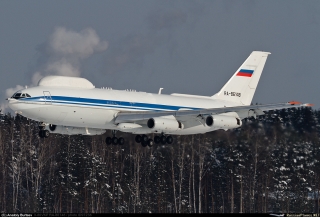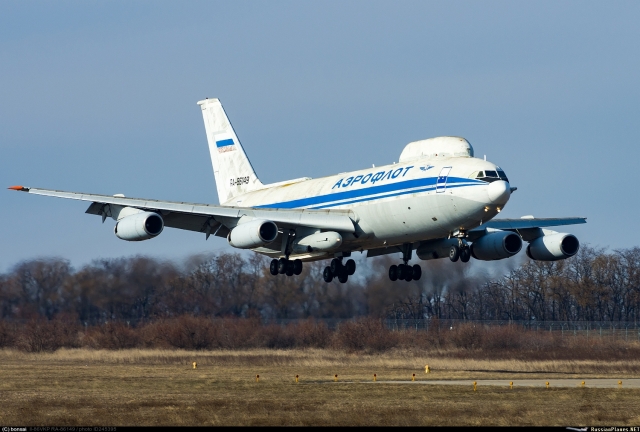Thieves steal radio equipment from Russia’s top secret doomsday aircraft
A ten minute deep dive analysis into this sensitive matter
Official news
On 7 December 2020, the RIA Novosti press agency has provided news about unknown persons having stolen radio equipment from the Il-80VKP air command post plane at the Taganrog-Yuzhny airfield in the Rostov region. The Ministry of Internal Affairs of Russia was notified about the matter after a representative of the Beryev Taganrog Aviation Scientific and Technical Complex (TANTK) addressed the police with the issue.
The situation relates to Ilyushin Il-80VKP with registration RA-86149 (construction number 51483205048), which was transferred to the TANTK for repairs and modernization work in the summer of 2019 and was planned to be returned back to service in 2022. According to the representative of TANTK, the aircraft was last inspected on 26 November and all instruments were found to be in place and properly sealed. After that the aircraft’s main entrance, the cargo compartment hatch has been sealed, not mentioning the three emergency entrances. The theft was only discovered on 7 December and according to the TANTK it could have happened anytime since the last inspection date. Police officers have also found fingerprints and shoe prints of the potential perpetrator(s) in the plane's cargo compartment.
Russia’s internal affairs ministry started a probe into this incident, having sent investigative and operational teams to the scene of the crime while the law enforcement officials from the internal affairs ministry’s investigation department have opened a criminal case. They are now working on several versions of the incident, ranging from simple burglars seeking for radio parts containing precious metals, through a group of insiders having direct access to the facility and the aircraft, up to an espionage thriller involving intelligence operatives of some rogue nation trying to get their hands on Russia’s best guarded nuclear secrets.
Comments
The mentioned story is, of course, becoming very juicy especially due to the nature of the aircraft itself - the Il-80VKP, also called Il-86VzPU (air command post) or Izdelye 65s, NATO code Maxdome, is by all means a very specialized aircraft containing top secret equipment required for the plane designed for use in the event of a nuclear war or a major disaster that destroys ground-based command infrastructure. It could be best compared to the US-made E-4B Nightwatch based on a Boeing 747-200B for the National Emergency Airborne Command Post programme or the E-6 Mercury TACAMO (Take Charge and Move Out) based on the Boeing 707.
Four such aircraft based on the Il-86 airliner were built for the Russian Federation - Aerospace Forces (RF VKS), all serving in the 8th Special Purposes Aviation Division at the Chkalovsky air base near Moscow. Back in 2011, three of them, registrations RA-86147, RA-86148, and RA-86149, were listed in service while the first one, registration RA-86146, has been seen stored for years at Chkalovsky, partially dismantled and without engines.
We could end up the story right here and get advantage of all the hits and likes for this article, finally one can hardly imagine a juicier clickbait than that. But the researchers always strive to get more insight to the whole story in the first place. So, let’s do some sober analysis.
Analysis
The news indeed does sound like a huge fiasco and a major embarrassment for the whole Russian Ministry of Defence. Finally, this aircraft was supposed to be guarded at least as carefully as nuclear weapons themselves, after all, in the event of a major conflict it can control the strategic forces of the Russian Federation.
If some rogue operatives managed to get aboard the aircraft and dismantle some of its sensitive systems, then, in the best case they rendered the aircraft inoperable and in the worst case, compromised Russia’s nuclear secrets and put the whole Strategic Missile Forces Central Command in jeopardy. If that was the goal, then the perpetrators have chosen their modus operandi wisely - instead of sneaking through a tightly controlled perimeter of the Chkalovsky air base, carefully guarded with machine guns and sophisticated sensorics and security systems, they simply used the situation when the aircraft has been moved off-guard to TANTK (by all means a specialized facility, yet still considerably less protected) and then successfully destroyed an air command post in a daring raid. Sounds like a great stuff for Tom Clancy’s novel.
Let’s have a look at the equipment this aircraft carries. Some of that is truly very specialized equipment carrying the highest security labels. One of the notable classified systems would be the Signal ASBU (automated combat control system), which receives, relays and transmits signals from the Kazbek nuclear suitcase to launch ICBMs and SLBMs in a retaliation strike against the enemy, when all communication and warning systems are disabled. The Kazbek system is an automated control system for nuclear response forces able to launch and command all of Russia's nuclear forces. There are three permanent suitcases, one for the president as the Supreme Commander, the second one for the minister of defence and the third one for the chief of the Russian General Staff. The suitcases do not stay with the aircraft, as they are always within the reach of the three appointed persons, carried by a uniformed communications officer in charge. The nuclear missile launch system will be activated if the code is entered into at least two of the three nuclear suitcases.
Other sensitive equipment include systems for centralized combat control (CBU), radio-based combat control commands (RBU) or classified communication equipment (ZAS) covering telecode, operational speech and audio telegraph information. The contents of the aircraft and the nomenclature of products are strictly classified, with very controlled admission, of course, until the moment when the metal workers at TANTK were allowed in the vicinity of the aircraft.
Assuming that the burglars were after those systems, the Russians could be potentially facing another troubling situation, such as Lt. Belenko’s defection to Japan with his MiG-25P jet which ultimately led to development of the MiG-25PD or the case of Col. Nesterets who passed on sensitive data registered on the RT-2PM2 Topol-M complex to the CIA and caused this system to be kept in rather limited numbers within the Strategic Missile Forces and swiftly replaced by the Topol-MR (RS-24 Yars) with a payload bus modified to carry multiple independently targetable warheads (MIRV). A compromise like that would inevitably lead to a speedy development and induction of the Il-96-400VzPU airborne command post based on the Il-96-400M long-haul wide-body airliner which has been in the works for some years already.
 Nevertheless, the sensitive equipment aboard the Il-80VKP sports a different approach to design: the hardware is not really secret, what is secret are the codes used for it. The parts of the complex which store codes are in the form of removable cassettes and/or setting mechanisms which are never stored aboard the aircraft. It is not that the hardware itself might not be of any interest for intelligence service of a foreign nation, yet the seizure of such equipment would not provide access to nuclear weapons or the chain of command. It is also questionable whether there is anything to learn from a Soviet designed electronic system from the early 1980s, especially concerning the sensitive nature of the complex and the resulting difficulties in obtaining it.
Nevertheless, the sensitive equipment aboard the Il-80VKP sports a different approach to design: the hardware is not really secret, what is secret are the codes used for it. The parts of the complex which store codes are in the form of removable cassettes and/or setting mechanisms which are never stored aboard the aircraft. It is not that the hardware itself might not be of any interest for intelligence service of a foreign nation, yet the seizure of such equipment would not provide access to nuclear weapons or the chain of command. It is also questionable whether there is anything to learn from a Soviet designed electronic system from the early 1980s, especially concerning the sensitive nature of the complex and the resulting difficulties in obtaining it.
Logically, there could be an entirely different, much less dramatic explanation of the story.
The Il-80VKP is by no means a new aircraft. Having been introduced in 1992, employing technologies from the early 1980s, much of its communication equipment is already obsolete or has completely lost relevance due to new generations of equipment using semiconductors and employing entirely different working methods. Through the years in service, some of the equipment racks have already been gradually replaced by newer, more compact and much lighter types. However, replaced is not the right word to use as the old crates cannot be simply removed. They are bulky and heavy and their placement has been taken into account at the time of the development of the fuselage. Removing a whole block of old equipment would negatively affect the centering of the aircraft, potentially causing the Ilyushin to roll over due to disturbed balance. The most convenient approach to all this is to let the old comms in place and haul them around as dead weight - which is exactly what the RF VKS does. As a rule, much of the mentioned old equipment is not even considered classified anymore, as this part of the equipment contains the rather widespread R-160/R-260 type receivers full of now-vintage resistors and KM-type capacitors, high-frequency filters and microcircuits.
Throughout the entire service life of the aircraft, these blocks would have been silently dismantled by the servicing staff looking for hard-to-obtain spares, the only difference is the level of sophistication of the dismantling process. A thief would simply steal the entire block, carry it outside the base, strip off all useful equipment (capacitors, resistors, gilded microcircuits, soldered elements, voltage-controlled oscillators) and then throw away the rest with the box. If he was lucky to pick some unused block and the warrant officers have managed to find a replacement in the warehouse, then it might have gone relatively off the radar. But once the stolen block turned out to be a part of the vital ZAS or ASBU complex, a swift investigation would relatively quickly pinpoint the perpetrator, with some serious prison terms as a consequence.
On the other hand, a smart technician would not simply crudely pull the not used radio block apart. Instead, he would neatly disassemble the box, remove the electronic blocks, carefully bite out KM-capacitors and other vital parts and not even touch the gilded microcircuits - they hardly contain gold worth few dollars and their removal is rather time consuming. After the procedure the technician would put all blocks back, quite often even keeping the very basic functions such as diodes and indicators intact. A brief check of these old systems by a warrant officer would never reveal that much of the equipment is already dysfunctional, especially when many officers have performed the checks with silent approval of the mentioned methods. These persons would know very well which equipment could be disassembled and which boxes should not be touched under any circumstances, especially those of the classified equipment or boxed which were constantly used on duty.
In our times, such methods of "maintenance" might sound unrealistic, but they perfectly reflect the dire situation of the Russian VVS in the post-Soviet era of the mid and late 1990s - lack of spare parts, dysfunctional logistics, mess in the communication between bases and warehouses and often very symbolic accounting. In such situation, most of the not used communication equipment not participating in the command and control of troops could be dismantled like this and the parts resold to other units. Finally, similar communication equipment was used throughout the entire Soviet territory, from personal radios to vehicle-based radio stations or specialized combat control vehicles such as 15V129 or 15V133.
The fact that the theft of the equipment on the Il-80VKP was discovered on 7 December, says very little about the time this "incident" could have happened. It is far more likely that the equipment was being dismantled for years and if done correctly, the fact of the theft was not revealed during routine maintenance procedures or audits. The curtain has only been taken down when representatives of the manufacturer started with their detailed checks, noticing that many old devices and complexes did not work or their parameters were entirely off limits. That was when the TANTK representatives have alarmed the police.
Of course, there is still the question of the official seals which are present on many boxes of the Il-80VKP. They are the old type seals with the five pointed star and the number of the aircraft plant or ARZ shop - one of the methods would be to freeze them using liquid nitrogen and then knock them off in their entirety. Another possibility would be to replicate an exact copy of the seal, thus getting easy access to pretty much any electronic block. During the maintenance check, the TANTK technicians always look at their own safety - if they find the seal broken, they do not even begin control checks rather than call in witnesses and only then open the box. If all contents of the box are OK, then a record is written, the function is checked thoroughly and then a new seal is applied. If some of the contents are gone, then an internal case is opened and the persons in charge might quickly get into some real trouble. But so far it looks as we got the third option here - that the seals were in place but some detail might have caught the attention of the TANTK employees and they have decided to independently check the integrity of the product.
The fact that the criminal case of the Ministry of internal affairs lists theft of property with little over RUB 1 million (USD 13,500) and specifically mentions communication equipment indicates that we are hardly talking about really sensitive devices missing.
As a matter of fact, there are rumours floating around that this particular Il-80VKP has been sitting on the ground for a very long time, not really having been involved in flight operations in at least a decade and that it would most likely be written off. Anyway, whether this is true or the aircraft still would be pushed back to service as announced, most of the equipment installed inside has been morally outdated for years and would likely still be dismantled to make room for installation of more modern semiconductor-based devices.
Photos: Bonsai, Kiriil Naumenko, Evgeny Volkov, Anatoly Burtsev, all kindly provided by RussianPlanes.net





